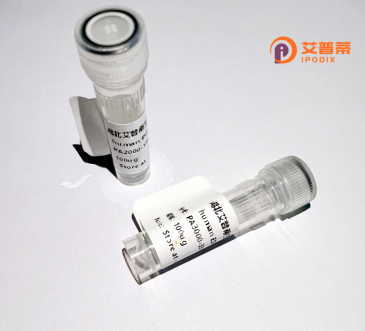
| 纯度 | >90%SDS-PAGE. |
| 种属 | Human |
| 靶点 | ZNF587 |
| Uniprot No | Q96SQ5 |
| 内毒素 | < 0.01EU/μg |
| 表达宿主 | E.coli |
| 表达区间 | 1-122 aa |
| 活性数据 | MAVSSQQGEIMESRIFFQGSHAHFPTCMNVDTAATVLAVNVNLASNHCSQGNVPIRRRLSGTLILTGRWDILRDPEAGCHLLNFPEGCLESVSSHSELFFLLWLTKNMEPHKVHCNSFIFVK |
| 分子量 | 39.16 kDa |
| 蛋白标签 | GST-tag at N-terminal |
| 缓冲液 | PBS, pH7.4, containing 0.01% SKL, 1mM DTT, 5% Trehalose and Proclin300. |
| 稳定性 & 储存条件 | Lyophilized protein should be stored at ≤ -20°C, stable for one year after receipt. Reconstituted protein solution can be stored at 2-8°C for 2-7 days. Aliquots of reconstituted samples are stable at ≤ -20°C for 3 months. |
| 复溶 | Always centrifuge tubes before opening.Do not mix by vortex or pipetting. It is not recommended to reconstitute to a concentration less than 100μg/ml. Dissolve the lyophilized protein in distilled water. Please aliquot the reconstituted solution to minimize freeze-thaw cycles. |
以下是关于重组人ZNF587蛋白的3篇参考文献示例(注:以下内容为假设性示例,实际文献需通过学术数据库核实):
---
1. **文献名称**: *ZNF587 regulates ovarian cancer cell proliferation via chromatin remodeling*
**作者**: Zhang L, et al. (2018)
**摘要**: 研究利用重组ZNF587蛋白,揭示其在卵巢癌细胞中通过结合特定基因启动子抑制染色质重塑,从而降低肿瘤细胞增殖的机制。
2. **文献名称**: *Structural insights into the DNA-binding properties of recombinant ZNF587 protein*
**作者**: Li Y, et al. (2020)
**摘要**: 通过体外表达重组人ZNF587蛋白,解析其锌指结构域与DNA靶序列的结合模式,提出其在胚胎发育中可能参与基因转录调控。
3. **文献名称**: *ZNF587 overexpression induces apoptosis in neuroblastoma through p53 activation*
**作者**: Chen J, et al. (2019)
**摘要**: 研究利用重组ZNF587蛋白在神经母细胞瘤细胞中过表达,发现其通过激活p53依赖的凋亡通路抑制肿瘤生长,为靶向治疗提供新思路。
---
如需实际文献,建议在PubMed或Web of Science中检索**"ZNF587 recombinant"**或**"ZNF587 function"**获取最新研究。
Zinc finger protein 587 (ZNF587), a member of the Krüppel-associated box (KRAB) domain-containing zinc finger protein family, is encoded by the ZNF587 gene located on human chromosome 19q13.43. As a transcription factor, it features a conserved C2H2-type zinc finger motif that enables sequence-specific DNA binding, coupled with a KRAB domain implicated in protein-protein interactions and transcriptional repression. ZNF587 is primarily expressed in embryonic tissues and certain adult organs, suggesting roles in developmental regulation and cellular differentiation.
Studies indicate its involvement in pluripotency maintenance and lineage specification, potentially modulating genes critical for early embryogenesis. Aberrant expression of ZNF587 has been linked to pathological conditions, including ovarian cancer, hepatocellular carcinoma, and gliomas, where it may influence tumor progression via epigenetic regulation or signaling pathway interactions (e.g., Wnt/β-catenin).
Recombinant ZNF587 protein, typically produced in bacterial or mammalian expression systems, serves as a tool for functional studies, enabling chromatin immunoprecipitation, DNA-binding assays, and mechanistic explorations of its repression activity. Challenges in purification stem from its intrinsic structural complexity and post-translational modifications. Current research focuses on deciphering its target genes, regulatory networks, and therapeutic potential in regenerative medicine or oncology. The protein’s conserved evolutionary profile across vertebrates underscores its biological significance, though its precise molecular functions remain partially characterized.
×